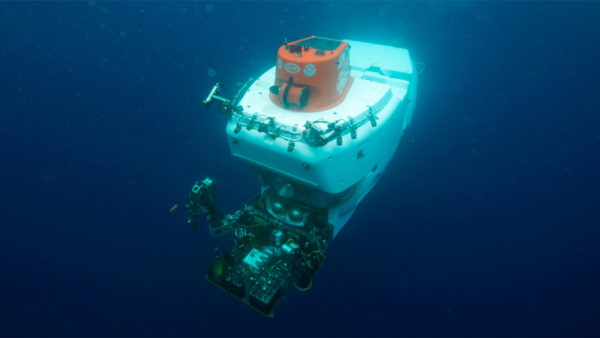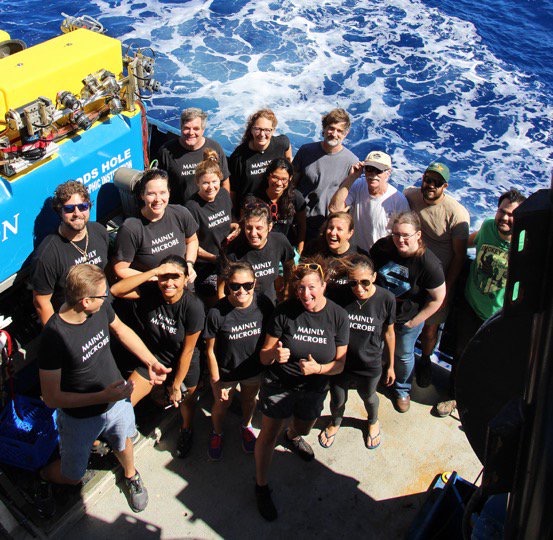In early August 2016, 24 early career scientists set sail from Woods Hole, Massachusetts on research cruise AT-36 to the northwest Atlantic continental slope. There, more than a kilometer beneath the water’s surface, new methane seeps and coral habitat had recently been discovered, and the multidisciplinary team of scientists was eager to conduct a more thorough investigation.
The primary aim of the expedition was to train young researchers (and potential future users) on the operational realities and scientific capabilities of National Deep Submergence Facility (NDSF) assets. With this in mind, the Research Vessel Atlantis was filled to the brim with an impressive technical arsenal. The human occupied submersible Alvin shared deck space with the autonomous underwater vehicle Sentry and a number of more standard oceanographic tools; daily plans sought to leverage these complementary capabilities in support of an integrated scientific program.
Among the scientific team were several members of the C-DEBI community, including Roman Barco, Anne Dekas, Colleen Hoffman, and Katrina Twing. It was a natural fit: “C-DEBI is committed to pursuing hypothesis-driven research in marine sediments and the marine subsurface,” says Dekas, who served as the co-chief scientist aboard the cruise. “Few oceanographic tools can sample the deep sea as precisely as those in the NDSF, making them an ideal fit for C-DEBI work.”
Barco traces his current deep sea research back to his time as a C-DEBI graduate fellow. “It developed as a side project years ago,” he recalls, “which was an investigation of the microbial colonization of different types of minerals in near-shore waters. This led to hypotheses about the deep-sea and the ocean floor, and I started thinking more actively about going deeper and participating in sampling opportunities with the use NDSF vehicles.”











 In celebration of the 30th anniversary of the NSF Science and Technology Center Program, Discover magazine featured C-DEBI in their
In celebration of the 30th anniversary of the NSF Science and Technology Center Program, Discover magazine featured C-DEBI in their 
 Please join me in welcoming Gwen Noda as C-DEBI Diversity Director who in her few weeks at USC, has dived into leading our diversity efforts to serve our students, postdocs, faculty, and other participants at USC and across the nation. Ms. Noda is a Los Angeles native who earned her B.S. in Marine Biology and M.A. in Biology both from UCLA with a research focus on benthic aquatic invertebrates. She brings an extensive background in informal education in the field and classroom to support and grow our education and outreach programs, e.g., as former Co-Director of the Center for Ocean Sciences Education Excellence COSEE-West and coordinator of the FLOW Citizen Science Monitoring Program at Bolsa Chica Wetlands and State Beach for Amigos de Bolsa Chica among others.
Please join me in welcoming Gwen Noda as C-DEBI Diversity Director who in her few weeks at USC, has dived into leading our diversity efforts to serve our students, postdocs, faculty, and other participants at USC and across the nation. Ms. Noda is a Los Angeles native who earned her B.S. in Marine Biology and M.A. in Biology both from UCLA with a research focus on benthic aquatic invertebrates. She brings an extensive background in informal education in the field and classroom to support and grow our education and outreach programs, e.g., as former Co-Director of the Center for Ocean Sciences Education Excellence COSEE-West and coordinator of the FLOW Citizen Science Monitoring Program at Bolsa Chica Wetlands and State Beach for Amigos de Bolsa Chica among others.


 We have many things to celebrate! First, congratulations to USC graduate student Gus Ramirez for successfully defending his Ph.D. thesis; he now embarks on a C-DEBI Postdoctoral Fellowship with Steve D’Hondt at URI. Congratulations also to C-DEBI Senior Scientist Steve Finkel, who will receive the American Society for Microbiology’s 2017
We have many things to celebrate! First, congratulations to USC graduate student Gus Ramirez for successfully defending his Ph.D. thesis; he now embarks on a C-DEBI Postdoctoral Fellowship with Steve D’Hondt at URI. Congratulations also to C-DEBI Senior Scientist Steve Finkel, who will receive the American Society for Microbiology’s 2017 



